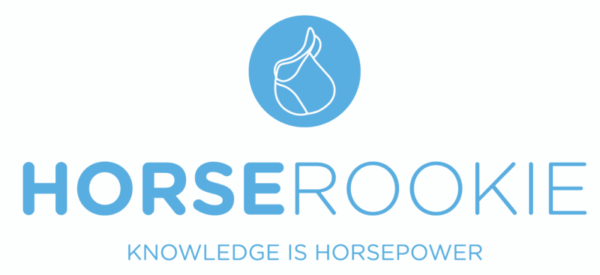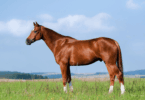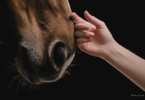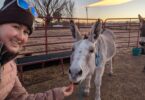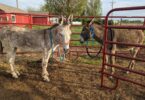Riding the Course
After learning everything you need to know about a course walk, it’s now time to use that knowledge to make the best decisions for you and your horse on course. And since, especially with horses, plans constantly change, we will cover how to adjust for contingencies.
Learn how to help turn the planned—and unplanned—parts of your round into educational building blocks for yourself and your horse.
Entering the arena
The way you pass through the in-gate and your first strides around the arena can make or break your round. We’ll explain why, and suggest strategies to use this critical time to help, not hinder, your round.

Source: Canva
Put On Your Game Face
It’s go time, and you’re up! The way that you enter the ring depends on the character of the horse and the character of you, the rider.
With a very tense horse or a very ambitious rider, it can be beneficial to enter the ring on a more casual note.
For example: Start with a gentle trot, followed by some walk steps, a big exhale and a nice pat on the neck. Gently gather the reins, shake off some of the rising excitement and nerves—and then proceed to Fence #1.
Alternatively, a seasoned horse and an aloof teenager might need to enter the ring in the most workman-like fashion: Start with a forward canter leading right into a prompt halt, then back a few steps before galloping to fence one.
These types of decisions should be made alongside a trusted horse person and should reflect the individual needs of the partnership entering the ring.
Presenting Fences
Likewise, the decision to familiarize your horse with any of the jumps, fill, decorations, or ringside distractions is an individual one.

Source: Canva
It can be beneficial to ride past areas that could surprise the horse as you enter the arena and prepare to begin your round. However, this strategy can be detrimental if not executed with skill and awareness.
Riding a spooky horse is best left to an experienced rider so that the horse can gain confidence.
It is equally important that less experienced riders have trustworthy mounts that teach them to become confident riders.
Unpredictability
When you enter the arena, it is critical to remain a thinking, reactive rider.
All the best planning in the world can become obsolete with horses.
When you enter the ring, you need to remain flexible and calm in case something does go wrong. There might be a dog loose in the ring, a wind gust that blows half the course over or rain that starts just as you enter (and spectators that open their umbrellas).
If someone were to fall off in the warm up ring, a loose horse could run into or near your arena.
Safety always comes first.

Source: Canva
It is important to know when to pull up on course and when to adjust your plan and keep going.
Now you have decided on the best strategy and route for your entrance and are ready to think and react to whatever happens once past the in-gate.
Next, we will arm you with tips to execute the plan you have created for how to ride your course.
Riding the course you visualized
Starting Out Right
After you hear the start tone, pick up a good canter and set a nice, regular rhythm. Give yourself an inviting approach to Fence #1.
Ideally, no matter how you enter the ring, the canter to the first fence will be bright, engaged, relaxed and straight. The rider should allow the horse to continue forward through the turn while gently guiding the horse’s focus to the first jump.
Giving your horse a forward, confident ride to Fence #1 sets a good tone for the rest of the course.
Follow the Leader
It is your job as the rider to clearly communicate the direction of travel to your horse. When we walk the course in advance, plan the track that is best for you both.
For some horse and rider pairs, the best route is the shortest, most efficient one. Others do better with longer routes that give the horse more time to see the jump and allow the rider more time to make adjustments.
No matter which plan is right for you, it is important to give your horse a track that allows him to focus on the next jump.

Source: Canva
After you take a smart approach to Fence #1—not too long and not too tight—you will ride the landing side of the jump to get the horse listening to the aids. Ride through the turn and line up the second jump or upcoming line without pulling.
Setting the horse up before the next jump is key to helping the horse focus its eye on the jump.
If the horse is either behind the leg or pulling through the hand in the final strides it will be difficult to arrive at the jump balanced. Do the work needed to achieve the correct balance as early as possible on the landing side of the previous jump.
Getting the “Right” Canter
Often (especially in large arenas) the approach to Fence #1 is designed to be taken from either canter lead. You will have chosen which lead to use with your horse during your course walk.
Whatever lead you choose, plan where in the arena you would like to pick it up, and then be precise.
Once the horse is cantering, send him forward and get a little extra momentum. Practicing getting the right canter thousands of times at home before showing is the key to knowing what the “right” canter feels like.
Starting out too slow and ending up too fast is a very common mistake.
Add and Subtract Strides
Walking the course gives us an excellent idea of how the lines will ride and how many strides to ride between the jumps.
Knowing how the lines should ride if we have the correct canter is also very important, because it can highlight what changes you need to make if you do not have the right canter.
For instance, if your trainer told you to ride a five-stride up the first line and you easily ride the line in six strides, you likely need to improve your canter and get your horse more forward before the next jump on the course.
Of course, these things are easier said than done. You can only use what you (and your trainer) know to create a solid plan for riding the course. And, you must be ready to make adjustments.

Source: Canva
When the plan doesn’t go to plan
The most important thing to be ready for when you enter the ring is a change of plan! This lesson prepares you to think on your feet—and on your horse’s feet—while on course.
That is easier armed with knowledge—so we will discuss options for a few of the most common situations.
All of the preparedness in the world does not eliminate the possibility that things do not go according to plan.
Experienced show riders know just how to handle almost any situation that may arise.
Inexperienced riders often feel rushed and overwhelmed when something goes wrong. If something does not go according to plan, take your time to regroup and make a new plan
There is more time between the jumps than many riders realize if you make changes early upon landing from the jumps. Be decisive and train the mind to keep thinking throughout the time in the show arena.
If you recognize that you are too fast or too slow after a couple of mistakes, use the ends of the ring to fix your pace and then get back on track.

Source: Canva
Common Scenario 1: Needing to Adjust Strides Upon Landing
At some point, every rider will enter a related distance differently than they planned.
For example, if you enter a normal four-stride line (60-foot) off of a very short stride, you will land closer to the back of the first jump in the line than is ideal (closer than the 6-foot you walked).
At this point, a thoughtful rider will adjust.
They will either immediately lengthen the stride to make up for the added distance and arrive at the second jump at an ideal distance; or immediately shorten the stride and add a stride (making it a 5-stride line) and arrive at the second jump at an ideal distance.
This requires that the rider make a choice and act quickly. If the rider does nothing upon landing, they will likely ride the line in four-and-a-half strides, making the second jump in the line very difficult for the horse to jump.
Common Scenario 2: A Jump Refusal
Another problem that will eventually happen to every rider is a refusal.
A refusal at a single jump could happen because of a missed distance or a spooky jump.
In some cases, the rider fails to get the horse’s eye on the jump in the turn and the horse is surprised by the obstacle.

Source: Canva
Whatever the scenario, there are a few rules that apply. If the jump is not disturbed at all, the rider should regroup and circle back to attempt the jump again.
It is typically advisable to take a nice, wide approach and give the horse the best chance of clearing the obstacle successfully.
In some cases, experienced riders will circle back quickly to minimize time faults obtained.
If the jump that was refused is disturbed at all, the tone will sound—indicating that the clock has stopped.
The jump crew will then rebuild the jump and repair the footing. The rider should take this time to regroup.
The tone will sound when it is safe to attempt the jump again. In the event that the refusal happened at a double or triple combination, the entire combination must be jumped again.
If the rider falls during the refusal and is not injured, he or she should get up, roll up their stirrups, take the reins over the horse’s head and lead the horse out of the arena.
Remounting in the arena is against the rules.
Common Scenario 3: The Footing Has Changed
In the event that the weather changed dramatically since your course walk, you could find yourself in the show ring without adequate studs.

Source: Canva
This problem is much more common on grass footing, but can also happen in a sand ring.
If the footing feels slippery in the turns, it is necessary to balance the horse on the outside aids prior to turning.
This is critical in order to prevent slipping and possibly falling in the turns.
If the footing has changed so much that the horse is slipping under the jump on takeoff, it is best to pull up, retire from the course, and try again another day.
You’ve Got This!
You have worked through a ton of information that will help make you a more calm, cool, collected—and a better prepared—competitor.
Next time the warmup steward calls your number as “on deck,” you will enter the arena with a better plan and greater understanding of how to ride your round—even if things do not go according to that plan.
Knowing your options helps reduce anxiety—and be a more competitive rider.
From the moment you back your horse down the trailer ramp at the next show, you will have knowledge and tools that empower you to be a better prepared, more proactive competitor—not merely a passenger in a shiny-for-the-show saddle.
Now, go have fun—and stay safe!
- A Horse Rookie’s Guide to
Show Jumping (PDF Download) - A Horse Rookie’s Guide to
Dressage (PDF Download) - A Horse Rookie’s Guide to
Trail Riding (PDF Download)
